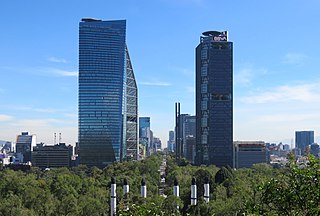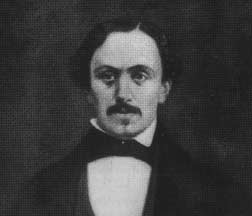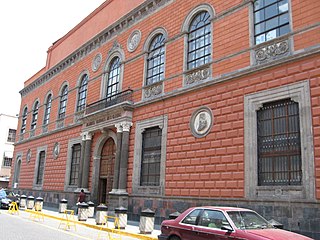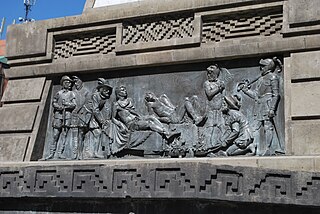
Paseo de la Reforma is a wide avenue that runs diagonally across the heart of Mexico City. It was designed at the behest of Emperor Maximilian by Ferdinand von Rosenzweig during the era of the Second Mexican Empire and modeled after the great boulevards of Europe, such as the Ringstraße in Vienna and the Champs-Élysées in Paris. The planned grand avenue was to link the National Palace with the imperial residence, Chapultepec Castle, which was then on the southwestern edge of town. The project was originally named Paseo de la Emperatriz in honor of Maximilian's consort Empress Carlota. After the fall of the Empire and Maximilian's subsequent execution, the Restored Republic renamed the Paseo in honor of the La Reforma.

Francisco González Bocanegra was a Mexican poet who wrote the lyrics of the Mexican National Anthem in 1853.

Club Santos Laguna S.A. de C.V., commonly known as Santos Laguna or Santos, is a Mexican professional football club that competes in the Liga MX. It is located in northern Mexico and represents the urban area of La Comarca Lagunera, made up of the surrounding municipalities of Torreón, Gómez Palacio, Lerdo and Matamoros.

The historic center of Mexico City, also known as Centro or Centro Histórico, is the central neighborhood in Mexico City, Mexico, focused on Zócalo or main plaza and extending in all directions for a number of blocks, with its farthest extent being west to the Mexico City Alameda Central. The Zocalo is the largest plaza in Latin America. It can hold up to nearly 100,000 people.

Ixcateopan de Cuauhtémoc is a town in Ixcateopan de Cuauhtémoc Municipality located in isolated, rugged mountains in the northern part of Guerrero state, Mexico. According to tradition, it is the final resting place of Aztec Emperor Cuauhtémoc, whose alleged remains were found under the parish church here in the mid-20th century. This church has been converted into a museum with displays a number of pre-Hispanic artifacts, offerings left in honor of the emperor and the alleged remains of Cuauhtémoc himself. This has been refuted by later research and by a Judging Commission of the Mexican government in 1976.

The Academy of San Carlos is located at 22 Academia Street in just northeast of the main plaza of Mexico City. It was the first major art academy and the first art museum in the Americas. It was founded in 1781 as the School of Engraving and moved to the Academia Street location about 10 years later. It emphasized classical European training until the early 20th century, when it shifted to a more modern perspective. At this time, it also integrated with the National Autonomous University of Mexico, eventually becoming the Faculty of Arts and Design, which is based in Xochimilco. Currently, only graduate courses of the modern school are given in the original academy building.

Gabriel Guerra was a Mexican sculptor. He was born in Unión de San Antonio, Jalisco and trained at Escuela Nacional de Bellas Artes in Mexico City where he studied with Miguel Noreña.

Tlaxcoaque is a plaza located in the historic center of Mexico City which has given its name to both the 17th-century church that is on it and the blocks that surround it. Historically this plaza and the church that sits on it have marked the southern edge of Mexico City, and today it is on the border of the historic center and Colonia Obrera. The church and plaza are somewhat isolated from the rest of the center due to the construction of wide streets, such as 20 de Noviembre and Fray Servando Teresa de Mier, that separate them from the surrounding buildings. Another notable building in this area is the police surveillance station, which was infamous in the 1970s as a place where detainees were tortured. This stopped after the 1985 Mexico City earthquake exposed handcuffed bodies which had evidence of torture on them. Today, the area around this plaza is semi-deserted outside of work hours and is considered to be a high-crime area. The church itself has experienced break-ins.

Colonia Guerrero is a colonia of Mexico City located just north-northwest of the historic center. Its borders are formed by Ricardo Flores Magón to the north, Eje Central Lazaro Cardenas and Paseo de la Reforma to the east, Eje1 Poniente Guerrero to the west and Avenida Hidalgo to the south. The colonia has a long history, beginning as an indigenous neighborhood in the colonial period called Cuepopan. The origins of the modern colonia begin in the first half of the 19th century, but most of its development occurred as a residential area in the late 19th and early 20th. Over the 20th century, several rail lines and major arteries were built through here, changing its character Cuauhtémoc borough. It is home to two early colonial era churches, the Franz Mayer Museum and one Neo-Gothic church from the Porfirian era.

Colonia Tabacalera is a colonia or neighborhood in the Cuauhtémoc borough of Mexico City, on the western border of the city's historic center. It was created in the late 19th century along with other nearby colonias such as Colonia San Rafael and Colonia Santa María la Ribera. From the early 1900s, it became a mixture of mansions and apartment buildings, with major constructions such as the now Monument to the Revolution and the El Moro skyscraper built in the first half of the century. By the 1950s, the area had a bohemian reputation with writers, artists, and exiles living there. These included Fidel Castro and Ernesto “Che” Guevara, who met each other and began planning the Cuban Revolution there. Today, the colonia is in decline with problems such as prostitution, crime, street vending and traffic. However, the area is still home to some of the many traditional Mexican cantinas that populated it in its heyday.
This is a list of events that happened in 2014 in Mexico. The article also lists the most important political leaders during the year at both federal and state levels.
Events in the year 1998 in Mexico.
Events in the year 1997 in Mexico.
Events in the year 1999 in Mexico.

The Monument to Cuauhtémoc is an 1887 monument dedicated to the last Mexica ruler (tlatoani) of Tenochtitlan Cuauhtémoc, located at the intersection of Avenida de los Insurgentes and Paseo de la Reforma in Mexico City. It is the work of Francisco Jiménez and Miguel Noreña in the "neoindigenismo", and was proposed to promote the new government of Porfirio Díaz.

San Quintín is a municipality in the Mexican state of Baja California. Its municipal seat is located in the city of San Quintín, Baja California. According to the 2020 census, it had a population of 117,568 inhabitants. The municipality has an area of 32,883.93 km2. There are a few National Parks and a World Heritage Site at Bahia de Los Angeles.

The Monumento a la Raza is a 50 meters (160 ft) high pyramid in northern Mexico City. It is located in the intersection of Avenida de los Insurgentes, Circuito Interior and Calzada Vallejo, in the Cuauhtémoc borough.

The Monumento Encuentro refers to two bronze statues seated on a bench in Colonia Tabacalera, Cuauhtémoc, Mexico City. Otherwise known as the bench of Fidel Castro and Che Guevara and the statues of Fidel Castro and Che Guevara, the artwork features sitting statues of Fidel Castro and Che Guevara, major figures of the Cuban Revolution (1953–1959). The monument references the first time both met in 1955 in Tabacalera.















